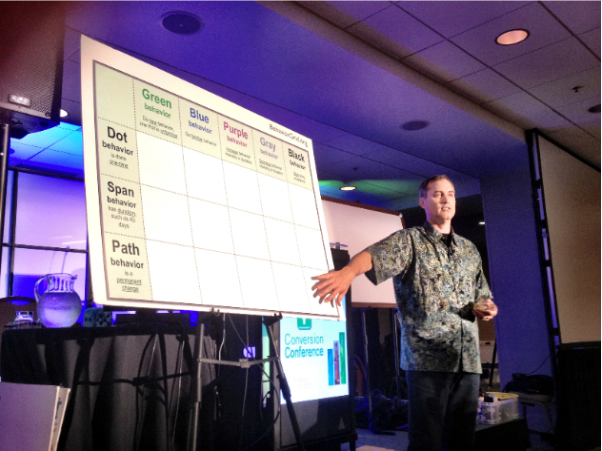The 2012 Conversion Conference tour started in San Francisco on March 5–6 with the largest event attendance in its three-year history. Alongside Marketing Optimization Summit and Predictive Analytics World as part of Data Driven Business Week, Conversion Conference focused on using the disciplines of UX design to influence user behaviors.
The 2012 Conversion Conference tour started in San Francisco on March 5–6 with the largest event attendance in its three-year history. Alongside Marketing Optimization Summit and Predictive Analytics World as part of Data Driven Business Week, Conversion Conference focused on using the disciplines of UX design to influence user behaviors.
Dr. BJ Fogg, Director of the Stanford Persuasive Technology Lab, began the conference by discussing his framework for persuasive design. Fogg is a psychologist who teaches unconventional classes that use Facebook applications to test behavioral theories. From this research, he developed a taxonomy for behavior types and a formula for predicting behavior change. His Behavior Grid plots the familiarity and recurrence of a behavior against its duration. This classification can assist with determining methods more likely to influence behavior change.

As well, Fogg presented his Behavior Model formula, which indicates that behavior change only occurs when a user’s motivation and ability intersect at the time of a stimulus “trigger.” For example, easier tasks require less motivation to accomplish, while motivated users are willing to perform more difficult tasks when prompted. According to Fogg, eliciting a desired behavior is a matter of understanding how motivated users are and decreasing the complexity of accomplishing a task.
The conference also featured breakout sessions with a variety of practitioners who gave advice on increasing user ability, motivation level, and triggers. John Ekman, the comedic and self-proclaimed Swedish authority on conversion rates, presented examples of how persuasion triggers from offline retail stores could translate to eCommerce UIs and how persuasive design techniques can improve usability by assisting shoppers. Kipp Bodnar from Hubspot reviewed Facebook’s new Timeline feature for brand pages, which he believes provides a richer experience for an audience to engage with and will result in more opportunities to trigger a conversion. Seth Berman shared how smartphones have altered email consumption behaviors of BabyCenter.com readers. With email being read more frequently on mobile devices, BabyCenter prioritized mobile website and application development and concentrated on one-handed usability to cater to nursing mothers checking their email.
Lightweight usability testing was discussed by several speakers. Steve Krug, author of Don’t Make Me Think, explained that usability testing is merely observing people using things, unlike focus groups where users self-report their opinions and past experiences. He also presented usability testing techniques from his new book, Rocket Surgery Made Easy. Krug believes that if held on a regular basis, usability tests that observe just three people using your product will uncover more usability problems than you can fix before the next test.
Other speakers agreed. James Niehaus from Symantec said, “The faster you test, the less you argue,” affirming the value of frequent and fast usability tests where stakeholders observe the users. Darrell Benatar from UserTesting.com demonstrated Krug’s “think aloud” testing method where users are recorded speaking their thoughts as they try to perform a task. Sandra Niehaus and Sara Sturtevant from Closed Loop Marketing stressed the importance of waist-to-head video of users in usability tests to best capture the body language, facial expressions, and gestures for additional cues.
But even before users physically or verbally react in a usability test, their brains are actively processing. Roger Dooley, author of Brainfluence, presented an overview of emerging neuromarketing studies that measure physiological responses to determine motivations behind behaviors. Dooley claimed that subconscious judgment patterns can be identified from such studies, and that they have practical implications. He cited examples such as:
- using simple language and fonts to increase the speed with which users process information to decrease the perception of effort required for a task.
- the efficacy of trust assertions (e.g., “You can count on us to get the job done.”) and timely apologies to build rapport.
- being cautious with photos of attractive women, as they cause men to be less patient, which can work in favor of restraining impulse behavior or against behaviors that require higher levels of motivation.
Tying the event together was Jared Spool’s description of maturing markets and the teams that succeed in them. Spool described how markets progress from mere access to technology, to feature additions, to refined experiences. Concentrating on UX instead of merely adding more functionality to a product indicates market maturity, according to Spool. He recommended that teams in mature markets effectively communicate a design vision, spend at least two hours every six weeks in usability testing, and reward design failures for the learning produced to succeed.
Steve Krug said, “Every person who is a designer or developer should take a usability course to make them sensitive to it.” Conversion Conference’s case studies, research, and entertaining critiques of audience websites should be beneficial to entire teams looking to provide refined experiences in mature markets. The tour continues on to Chicago, Florida, Germany, and the UK later this year.






